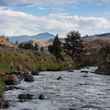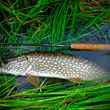The weekend before I arrived in Utah for the Outdoor Retailer show, I creek hopped with my kids. We had a Tenkara rod and a 4-weight fly rod. Both are perfect for playing 6-inch cutties on Bear Creek, a Snake River tributary in eastern Idaho.
We also had a to-do list. The Backcountry Hunters & Anglers Summer Scavenger Hunt for kids. Something round: snail shell. Five pieces of trash: bailing twine, two candy wrappers, a bottle cap and a nicotine patch. Unused. My son really wanted to find the person going without the patch once I told him what it was for. I assured him if we saw anyone wading and shaking, we'd hand over the patch we considered part of our scavenger trash pile.
In addition to the list's things-to-find, there are things to do. Dunk your head in the river. Done. Catch a fish, name it and release it. Jaws and Smalls. And pose with a public lands sign. We hiked the Bear Creek drainage all the way to an old backcountry ranger station. There's a dull, brown sign with even duller, yellow letters labeling the land public as part of the Caribou-Targhee National Forest. My kids happily hugged it as theirs for the photo op.
"Education is the main reason for our scavenger hunt," says Land Tawney, Backcountry Hunters & Anglers President and CEO. "There's a lot of people in the country who don't know we hold title to 640 million acres of public land. Let's start with our kids. They learn about our great resource and share that with others."
A few days later, I'm shooting photos of signs again. Hundreds of signs. These are hand drawn and held by adults rather than my kids. The diversity of various outdoor recreation preferences represented is significant. There's even camo in the crowd of nearly 3,000 marching from the Outdoor Retailer show in downtown Salt Lake City, Utah to the Beehive State's capitol steps a mile up the hill.
"This march is the outdoor industry's opportunity to demonstrate our collective conviction that public lands belong to every citizen of the United States," says Amy Roberts, Outdoor Industry Association executive director. "They are not only the foundation of our industry, they are fundamental to our national heritage."
The Outdoor Industry Association promoted the This Land is Your Land march and offered a designated Public Lands Action Center on the show floor. Some attendees embraced it while others said it made the show too political. Maybe so, but without some political steam, those not making signs won't have anyone to sell to because their customers won't have places to play anymore and won't need all that new gear. That's the simplest way to break down the dynamics of the situation as I explain the scene to my kids.

"I get it mom," my older son says. "Public lands are like the public library. Anyone can go in."
But if the door is locked, there's no going in. Closed means no one goes in the place meant for everyone.
Find in the land, or the library, whatever it is you're after then share what you learn, always knowing you can go back for more. There are more brooks, and books, to research. More woods, and words, to study. Regardless of what you plan to do with what you find, the land and the library are for all.
"This alliance between kayakers and climbers and the hunting and fishing community is a powerful voice," Tawney says. "This is a pretty exciting time when you think about politics and how things are done. People are banding together to make a difference."
It doesn't matter if you hug a sign or hand draw one. The public lands represented in your effort are worth keeping unlocked for everyone.
































Comments